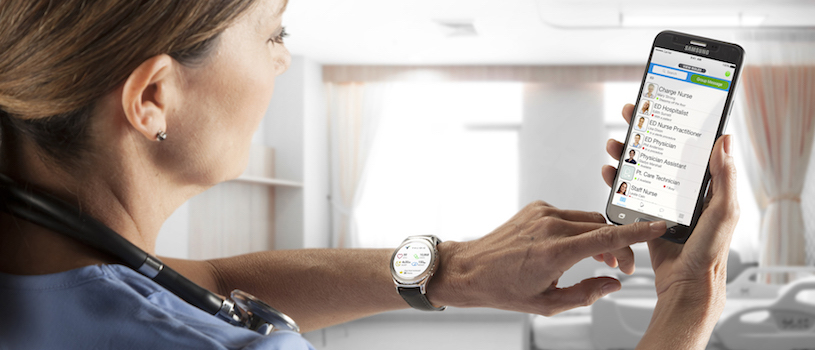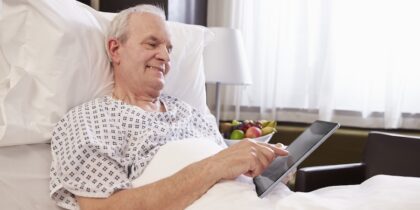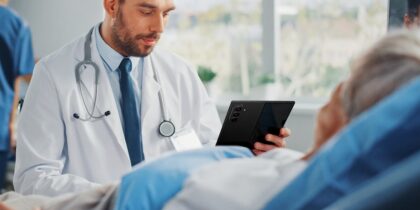Fall prevention in hospitals requires a multipronged approach, involving multiple teams, disciplines and an overall organizational culture focused on reducing fall numbers to improve patient care. According to the Agency for Healthcare Research and Quality, falls impact between 700,000 and 1,000,000 Americans each year, but advancements in technology in nursing are demonstrating serious potential to bring those numbers down, since they are often the first line of defense.
A new pilot study from the Journal of Medical Internet Research (JMIR) has highlighted how IoT devices can make nurses’ work easier and decrease fall risks.
IoT Devices Address High-Risk Periods
Patient falls, a third of which are believed to be preventable, can result in lacerations, fractures and internal bleeding, and can add $3,500 to $14,000 to a hospital stay. What makes them so difficult to address is that they can occur at essentially any time, meaning patients are at risk for falls from confusion, frequent visits to the toilet, the side effects of medication, transfers and even something as simple as getting out of bed.
Hospital teams engage many different resources, from physical design to monitoring practices, to reduce the risk and severity of falls, but IoT devices, in particular, are emerging as highly effective in helping nursing staff minimize fall risks in periods that involve patients transitioning in and out of bed.
A New Level of Accuracy
Bed alert systems are nothing new, as hospitals already use a range of monitoring and altering devices to supplement fall prevention strategies. Their downfall though, has been accuracy.
While alerts can be extremely helpful to nurses, that’s only true if they can be trusted.
According to the JMIR paper, studies have found that 80 to 99 percent of monitor alarms are “false or clinically insignificant,” contributing to “alarm fatigue” in nursing staff. These repeated false alarms (from systems with a low positive predictive value, or PPV) logically condition nurses to ignore alerts and potentially miss true emergencies.
Technology in Nursing Focused on a Positive PPV
What makes the JMIR system pilot so interesting is its specific focus on improving the PPV for monitoring alerts. The study, conducted at a 317-bed teaching hospital in Massachusetts over a year, focused on patients over 18 years old who were determined to be high-risk, or with a Morse Fall Scale score equal to or greater than 45.
It featured a design that used a large sensor pad (approximately 46 x 30 in.) placed between a patient’s mattress and bed sheet that monitors patients from shoulder to thigh. If a patient makes an attempt to leave their bed, it then alerts the appropriate nurses and nurses’ aids.
When it calculates the increased probability of a patient exiting the bed, the system’s software algorithm communicates with nurses’ mobile devices, such as a smartphone, smartwatch or tablet, while also making information available via a dashboard when needed. The dual-pronged alert comes in the form of an audible message that reminds the patient not to leave the bed without aid and at the same time alerts the nurse via vibratory, audible and visual cues.
Perhaps most importantly, the SensableCare System gives nurses access to a breadth of critical information including the ability to visualize how a patient is positioned in the bed along with the patient room number, and additionally informs other nurses when a patient is receiving assistance. SensableCare is powered by a predictive algorithm that also has the ability to identify patient activities (sitting up, stirring, etc.) before they attempt to leave the bed.
The results of the pilot were significant:
-
A PPV of 62.1 percent, meaning medical staff can more accurately pinpoint the need for treatment and diagnoses.
-
Nursing staff responding to alerts in an average of 45.9 seconds, compared to an overall average of 10.4 minutes.
-
No bed falls recorded in 234 days.
The system even empowers nurses to customize their alerts — they are able to adjust settings for each individual patient, decide how quickly they receive alerts and also receive notifications when a patient is stirring after being still for more than 20 minutes.
Relief for Nurses
Using technology in nursing to prevent falls presents an added potential benefit for the professionals themselves.
Nurses, who are already combating fatigue, stress and burnout as on-the-job health concerns, will likely benefit from not only having reduced concern in their daily work, but also from a reduction in patients who are being treated for preventable conditions. With additional data collected from the SensableCare system, nurses can anticipate high-activity times and identify movement patterns for patients.
Overall, IoT devices can be helpful to healthcare decision-makers looking to improve hospital operations, especially when used as one piece of a puzzle that works together to prevent patient falls, and even address other serious medical phenomena within the hospital setting.
Solutions like these and other technology in nursing applications are most powerful when assessment results are tied directly to patient care plans, so that staff at all levels have optimal decision support and insight.
Learn more about how healthcare technology solutions can enhance efficiencies and improve the patient experience.







